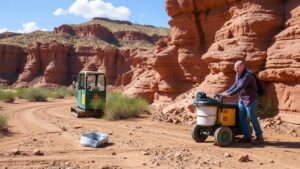How the Gold Placers Along the Rio Grande Near Truth or Consequences Were Explored
Exploration of Gold Placers Along the Rio Grande Near Truth or Consequences
The Rio Grande has been a significant river in North America, not only for its ecological importance but also for its role in the history of gold mining, particularly near the town of Truth or Consequences, New Mexico. This article provides an in-depth examination of how gold placers in this region were explored, detailing the methodologies used and the historical context that contributed to mining activities.
The Historical Context of Gold Mining in New Mexico
Gold discovery in New Mexico began in the mid-19th century, spurred primarily by the California Gold Rush of 1849. Although California attracted the bulk of prospectors, many ventured into the southwestern territories. significance of the Rio Grande in mining history lies in its landscape, which offered numerous opportunities for placer mining.
- The establishment of the nearby communities accelerated mining interest.
- Gold mining in New Mexico provided crucial economic benefits, influencing local communities.
Understanding Placer Mining
Placer mining involves the extraction of valuable minerals from alluvial deposits, typically found in riverbeds or on riverbanks. This form of mining is simpler than hard rock mining, as it often relies on gravity to separate gold from other materials. The nature of the Rio Grande’s landscape, with its shifting beds and confluence of rivers, made it a prime site for such operations.
- Gold is heavier than most other minerals, allowing it to settle at the bottom of riverbeds.
- Techniques such as panning, sluicing, and hydraulic mining were employed by early miners.
Exploratory Techniques and Discoveries
The exploration process for placer gold along the Rio Grande included a variety of methods. In the initial stages, prospectors often relied on simple tools and techniques:
- Panning: A basic method using a shallow pan to wash gravel and separate gold.
- Sluicing: Involving a long trough that allows water to flow over materials, separating lighter particles from heavier gold.
- Hydraulic mining: Utilizing high-pressure water jets to dislodge rock material.
According to the United States Geological Survey (USGS), significant placer gold deposits were identified near Truth or Consequences, particularly in the late 1800s. Notable discoveries included the first recorded mining activity at the nearby Hot Springs area, indicating the richness of the region.
Case Studies of Gold Exploration
One notable example includes the work of the 19th-century prospector William H. Emory, who explored the region extensively. Emorys documentation provided critical insights into the geological formations around the Rio Grande, helping future prospectors identify potential gold-rich areas.
The Gold Rush in the 1870s
During the 1870s, a surge in gold exploration occurred, primarily due to improved transportation infrastructure. The arrival of the railroad made it easier for miners to access remote areas. The mining boom led to the establishment of several mining companies dedicated to placer operations along the Rio Grande.
Technological Advancements and Their Impact
As knowledge about placer gold mining matured, so did the technology used. Hydraulic mining techniques began to dominate by the late 19th century, allowing for greater extraction efficiency.
- Introduction of steam-powered pumps significantly increased water flow rates.
- Development of mechanical rockers and long toms further enhanced gold recovery rates.
Environmental Considerations and Regulations
With the boom of placer mining, environmental impacts became a growing concern. The removal of significant amounts of earth altered the landscape and disrupted local ecosystems. By the early 20th century, regulatory frameworks began to emerge, addressing issues such as land reclamation and water rights.
Modern Implications of Historical Gold Exploration
Today, the legacy of gold mining along the Rio Grande continues to influence the region. Modern techniques such as geophysical surveys and environmental impact assessments inform contemporary mining practices. State regulations now emphasize sustainable mining operations to protect both the environment and local communities.
Conclusion and Takeaways
The exploration of gold placers along the Rio Grande near Truth or Consequences has a rich historical legacy shaped by various economic, social, and technological factors. Understanding this context not only illuminates the past but also informs present-day practices in mining and environmental stewardship.
- Gold placer mining has significantly impacted the economic development of New Mexico.
- Historical techniques laid the groundwork for modern exploration methods.
- Regulatory frameworks today ensure a balance between resource extraction and environmental protection.



